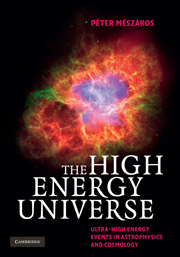Book contents
- Frontmatter
- Dedication
- Contents
- Preface
- 1 Introduction
- 2 The nuts and bolts of the Universe
- 3 Cosmology
- 4 Cosmic structure formation
- 5 Active galaxies
- 6 Stellar cataclysms
- 7 Gamma-ray bursts
- 8 GeV and TeV gamma-rays
- 9 Gravitational waves
- 10 Cosmic rays
- 11 Neutrinos
- 12 Dark dreams, Higgs and beyond
- Epilogue
- References
- Glossary
- Index
9 - Gravitational waves
Published online by Cambridge University Press: 05 July 2014
- Frontmatter
- Dedication
- Contents
- Preface
- 1 Introduction
- 2 The nuts and bolts of the Universe
- 3 Cosmology
- 4 Cosmic structure formation
- 5 Active galaxies
- 6 Stellar cataclysms
- 7 Gamma-ray bursts
- 8 GeV and TeV gamma-rays
- 9 Gravitational waves
- 10 Cosmic rays
- 11 Neutrinos
- 12 Dark dreams, Higgs and beyond
- Epilogue
- References
- Glossary
- Index
Summary
Ripples in space-time
The gravitational force field, as discussed in Chapter 2, is described in General Relativity as a distortion of space-time caused by the masses in it, which results in any small test mass in this space-time moving along the curvature of the space-time. If the position of the large source mass (or masses) which dominate a certain region of space-time is varying, the space-time structure readjusts itself to reflect the changed positions of the source masses, after a delay caused by the fact that the information about this change of position of the source masses cannot be communicated faster than the speed of light. That is, the space-time at some location r away from the source mass which has moved can respond to this change only after a time t = r/c. This traveling information about changes in the space-time structure is the basis of the phenomenon of gravitational waves, which can be thought of as ripples in the texture of spacetime that travel at the speed of light.
One can visualize this also in a simpler quasi-Newtonian picture, provided one accepts the relativistic principle that information travels at most at the speed of light. Imagine two equal masses M in a circular orbit of radius d around each other, in a plane parallel to the line of sight to the observer, with the center of mass of the orbit (the mid-point of the line separating the two) being a fixed point in space at a distance D from the observer (see Fig. 9.1).
- Type
- Chapter
- Information
- The High Energy UniverseUltra-High Energy Events in Astrophysics and Cosmology, pp. 140 - 153Publisher: Cambridge University PressPrint publication year: 2010



